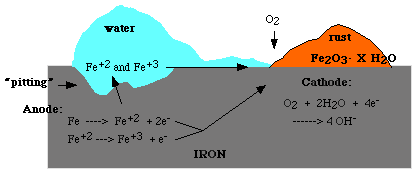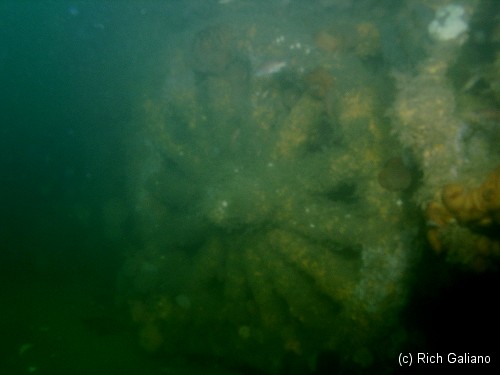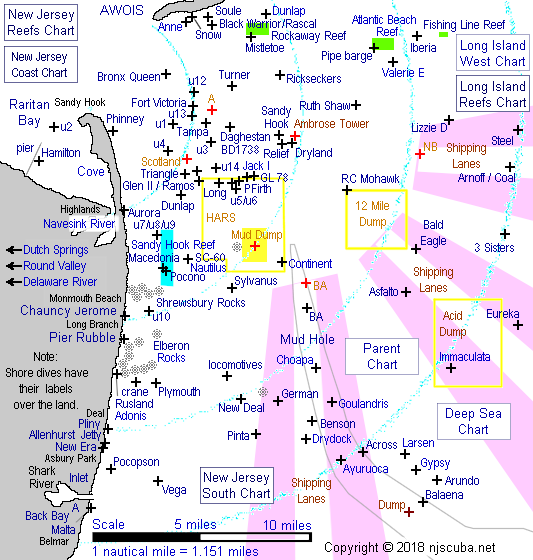Locomotives (2/2)

Old Trains Discovered off NJ Coast
are Called 'Real Archaeological Find'
By John Shiffman
Inquirer Staff Writer
Posted on Sun, Sep. 19, 2004
Two rare, pre-Civil War steam locomotives, almost completely intact, have been discovered sitting upright, side-by-side, at the bottom of the Atlantic Ocean, several miles off the central New Jersey coast. The submerged engines were discovered in 1985 by a charter-boat captain. But the significance of the find was not realized until two years ago, and not made public until Friday when a federal judge ordered the relics protected.
In the next few days, a surrogate U.S. marshal will dive 90 feet to the ocean floor a few miles east of Asbury Park, to attach a laminated notice to one of the locomotives. The notice includes a marshals' warning that tampering or poaching is now illegal. Two organized groups of amateur railroad and diving enthusiasts obtained the court order. They hope to retrieve and restore the distinctive and decorative steam engines, which are encrusted with a century and a half of barnacles and other sea life.
"It's a real archaeological find - there are only a handful from that era that still exist, " said David Dunn, director of the Railroad Museum of Pennsylvania, which is not involved. The six-wheeled engines are among the earliest American workhorse locomotives, designed during "an era when these machines were considered the space shuttles of the mid-19th century."
Jim Wilke, a railroad historian who lives in Los Angeles, said the find is unusual because "These machines are exactly as they were when they went down in the early 1850s." Most similar engines that survived to become museum relics, he said, were refitted again and again over decades, and represent hybrids with modernized parts. "These engines are extremely rare, " he said. The Smithsonian Institution, for example, owns a similar one, the Pioneer. A somewhat smaller, slightly younger, eight-wheeled steam engine, the People's Railway No. 3, is on display at the Franklin Institute.
John H. White, a former railroad curator for the Smithsonian, described the discovery of the two steam engines near New Jersey as "unusual, an oddity." "They don't tell anything we don't already know, " White said. "It's just interesting that they survived all this time. We don't have much from the 1850s. These are new pieces that were unknown."
To recover the steam engines from the Atlantic, the leaders of the diving and train enthusiast groups acknowledge they will need professional help. "This is, really, out of our realm, " said Victor Crisanto, chair of the New Jersey Museum of Transportation, which won the legal protection for the engines. The private museum has operated the Pine Creek Railroad, a railroad preservation organization at Allaire State Park, since 1952.
The group took the first legal step on Friday when it appeared before U.S. District Judge Joseph Irenas to ask for custody of the abandoned steam locomotives. They presented him with several pieces of physical evidence removed from the engines, including a foot-long bell and a 38-inch piece of decorative trim that hung above a wheel. "They could probably raise this thing without a court order because they are outside of New Jersey waters, but the real reason to do it is to protect their rights and keep interlopers away, " said Peter E. Hess, a Wilmington lawyer who represented the group.
The discovery is bound to become more publicized this month, Hess said, and will be featured on a History Channel documentary tomorrow at 9 p.m. "Everyone and their brother will want to go and try to grab a piece of brass off the trains, " Hess said. Crisanto and historians said they have little information about the engines' history - the precise year they were built, for example, or how they landed at the bottom of the Atlantic Ocean. But by analyzing certain clues - the wagon-top boiler and the valve controls, for example - historians believe the steam locomotives were manufactured in New England, probably Boston, between 1851 and 1854.
Beyond that, they say, little is certain, because railroad records were poor. Some historians suspect the engines slipped off a freighter headed south during a storm. But that is just a guess. Apparently, the engines sat undisturbed several miles from Asbury Park for more than a century, until 1985, when a charter-boat captain, Paul Hepler, found them while checking netting.
"The captain told me about them years ago, " said Dan Lieb of Neptune, the president of the New Jersey Historical Divers Association. "We were out on his boat, looking for lobsters, exploring shipwrecks. And when he told me about the locomotives, I thought, 'I don't want to look at trains, ' I want to see shipwrecks." Years later, Lieb said, he finally decided to see the trains for himself. He and fellow divers soon became infatuated. They took pictures and made drawings. Then he began making inquiries via the Internet.
At first, some speculated that the trains were sunk by the Germans during World War II, citing well-known attacks in the area at the time. Eventually, the divers' information and details reached White, the former Smithsonian curator. "They finally sent me a videotape - and I said, 'Aha! I think I know what these are, ' " White said. "The cylinders were on an angle, a very antique feature. The double valves, one on top of each other, another antique feature." they were tank engines, circa 1850.
Lieb, who had been reading White's book, American Locomotives: An Engineering History, 1830-1880, took the news to Crisanto and his fellow train enthusiasts. "They came to one of our board meetings and brought drawings, pictures, a few artifacts, " said Crisanto, the all-volunteer museum's chairman. "And ... our jaws kind of hit the ground."
Contact staff writer John Shiffman at 856-779-3857 or
jshiffman@phillynews.com
Raising the Locomotives
The suggestion in the television program that the locomotives be raised and put on display borders on absurd. Each one weighs perhaps 35 tons, or more, covered with marine growth, and filled with water. Raising the locomotives, which have been weakened by over 150 years of saltwater corrosion, would cost hundreds of thousands of dollars to execute properly, and even then would have a high likelihood of damaging or destroying them.
If the locomotives ever were brought to the surface, then the almost impossible task of preserving them would begin. Exposure to air would accelerate the corrosion process a hundred-fold ( air contains 21% highly reactive gaseous oxygen, seawater contains approximately 0.5% dissolved oxygen. ) Without extreme measures, the locomotives would disintegrate into piles of rust flakes in just a few years, like the old anchors that you find in front of restaurants at the shore.

Proper conservation and preservation of the locomotives would probably involve decades of immersion in freshwater to remove salts, combined with electrolytic treatment to stabilize the remaining metal. Successful conservation of small iron objects is difficult; conservation of the 35-ton ** locomotives over many years would certainly cost even more than raising them in the first place - it is completely unrealistic.
Even if all these hurdles were overcome, the end result would be two ugly rust-pitted partial locomotive hulks, stripped of almost all of their equipment and running gear and swathed in anti-corrosion grease - hardly as charming as the photogenic little Pioneer above. It would probably be cheaper and easier to just build new ones from old blueprints, and those would have the added benefit of actually functioning, which these two never will again.
The only realistic fate for these locomotives is to be left on the bottom of the ocean exactly where it is, where it could reasonably be expected to last for another 100 years or perhaps longer. To get some idea of the complexity that would be involved in raising and preserving iron objects of this size, peruse the following pages, keeping the thought "35 tons" in mind as you do:
Any private operation to raise one of these locomotives would be a far cry from the US Navy's multi-million dollar efforts to raise the Hunley and the Monitor. To attempt this project on a shoestring budget would be a crime.
** Based on the observation that the 11 ton Pioneer is 3/4 the size of the sunken locomotives, a quick calculation gives an empty weight of 26 tons each. Since such things never scale linearly, this is almost certainly an underestimate, so 30 tons is a conservative figure.
Subtract the lightweight wooden sections that have rotted away, and small brass parts that have been removed - several hundred pounds at most.
Add 150 years of rust and encrustation. The accepted formula for rust is:
Fe2O3nH2O where n = 3/2
A simple calculation shows that corroded iron gains 67% in mass when it blooms into rust. Of course, this applies only to the surface layers of the metal, to a material depth that I cannot estimate, but I would guess between 1/16" and 1/4 ". Apply this to the entire surface area, including internal spaces. Some external rust will flake off.
To start estimating the weight of encrustation, remember that sea anemones are 99% water. Seawater weighs 64.6 lb/cu-ft, and the anemones could be assumed to form a 1-2 inch jacket over the entire external surface of the locomotives. I would guess at least a ton of sea anemones ( won't that be fun to clean up after drying in the sun? ) Stony coral is considerably heavier than water, and so would have an even greater effect. Mussels and hydroids could be scraped off prior to the lift.
Finally, add boilers and cylinders full of seawater - perhaps 3000 lbs of water weight that is not going to drain quickly.
I think 35 tons is a reasonable estimate for the weight of a single fragile locomotive that would have to be lifted out of the water without breaking it into pieces in the process.
Controversy over the "Arrest"
A lot of New Jersey divers have very strong opinions on the subject of arresting this or any wreck. Arresting a wreck is no more or less evil than taking away artifacts. The ocean eventually digests everything, and what is not recovered will inevitably be lost. Those wrecks that are truly of historical significance should be protected and left to professional archaeologists. Such wrecks are rare. Underwater archaeologists are even rarer, and would not get to even a tiny fraction of what is down there if it was all reserved for them. Like many environmentalists, archaeologists can be prone to extreme opinions. Here are some excerpts of an email that I received from an armchair archaeologist:
Dear editor,
As a nautical archaeologist, I find your website unethical and, in places, downright illegal.
...
I hope you die in one of your ill-conceived "adventures" ( excuse me while I die laughing. )
Cheers,
[Name Withheld]
This fanatic turned out to be attached to a major maritime museum that I will not name, and someone whose job deals with the public on a daily basis. ( I forwarded the message to his HR director; I hope he was fired. The moral of the story is: don't use your work email for death threats! ) Fortunately, this one nut is not indicative of marine archaeologists in general.
I don't know if these locomotives really qualify as historically significant and deserving of such jealous protection. In any case, the point is moot - there is nothing left to be taken from them anyway. If you were greedy and selfish enough, you could get some explosives and blast a wheel off or something, and I agree with the court that would be wrong. The arrest also forbids throwing a grappling hook into the wreck, which is reasonable, since I have seen the damage that has been done already. The arrest does not otherwise prevent divers from visiting the site.
Everyone is getting much too upset about this. How many of you ever wanted to dive these things before? How many have ever dived any of the subway cars, and how many have never even considered diving on a train? ( Isn't that right up there with diving on garbage? ) Tell the truth, how many have ever wanted to dive on anything but a bonafide shipwreck? So why are these locomotives suddenly so interesting now? Perhaps they should be preserved. At any rate, the organizations that have arrested the locomotives are tiny, and could never raise the sums necessary to properly raise and restore them, so they will be down there for a long time to come, and hopefully now unmolested by junk collectors. If anyone ever tries to arrest a popular wreck like the Mohawk, I'll be the first one to say lynch 'em, but in this case it may be right the right thing to do.
See Maritime Salvage Law by Michael C. Barnette, with sample arrest papers



Questions or Inquiries?
Just want to say Hello? Sign the .